Volgograd
| Volgograd Волгоград (Russian) | |
|---|---|
| - City[1] - | |
 Counterclockwise: the Motherland Statue, the railway station, Planetarium, The Metrotram, Panorama of the City, Gerhardt Mill, Mamayev Kurgan | |
.svg.png) Location of Volgograd Oblast in Russia | |
 Volgograd | |
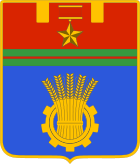 |
 |
Coat of arms |
Flag |
| Anthem | none[2] |
| City Day | Second Sunday of September[1] |
| Administrative status (as of February 2010) | |
| Country | Russia |
| Federal subject | Volgograd Oblast[3] |
| Administratively subordinated to | city of oblast significance of Volgograd[3] |
| Administrative center of | Volgograd Oblast,[3] city of oblast significance of Volgograd[3] |
| Municipal status (as of March 2010) | |
| Urban okrug | Volgograd Urban Okrug[4] |
| Administrative center of | Volgograd Urban Okrug[4] |
| Head[5] | Alexander Chunakov |
| Representative body | City Duma[5] |
| Statistics | |
| Population (2010 Census) | 1,021,215 inhabitants[6] |
| - Rank in 2010 | 12th |
| Population (2002 Census) | 1,011,417 inhabitants[7] |
| Time zone | MSK (UTC+03:00)[8] |
| Founded | 1589[9] |
| City status since |
the end of the 18th century[1] |
| Previous names |
Tsaritsyn (until 1925),[9] Stalingrad (until 1961)[9] |
| Postal code(s)[10] | 400000–400002, 400005–400012, 400015–400017, 400019–400023, 400026, 400029, 400031–400034, 400036, 400038–400040, 400042, 400046, 400048–400055, 400057–400059, 400062–400067, 400069, 400071–400076, 400078–400082, 400084, 400086–400089, 400093, 400094, 400096–400098, 400105, 400107, 400108, 400110–400112, 400117, 400119–400125, 400127, 400131, 400136–400138, 400700, 400880, 400890, 400899, 400921–400942, 400960–400965, 400967, 400970–400979, 400990–400993 |
| Dialing code(s) | +7 8442 |
| Website |
www |
| Volgograd on Wikimedia Commons | |
Volgograd (Russian: Волгогра́д, IPA: [vəɫɡɐˈɡrat] (![]()
![]()
![]()
History
_(1857).png)
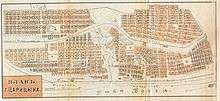
Tsaritsyn
Although the city may have originated in 1555, documented evidence of Tsaritsyn at the confluence of the Tsaritsa and Volga rivers dates only from 1589.[9] Grigori Zasekin established the fortress Sary Su (the local Tatar-language name means "yellow water" or "yellow river") as part of the defences of the unstable southern border of the Tsardom of Russia. The structure stood slightly above the mouth of the Tsaritsa River on the right bank. It soon became the nucleus of a trading settlement.
In 1607 the fortress garrison rebelled against the troops of Tsar Vasili Shuisky for six months. In 1608 the city acquired its first stone church, St. John the Baptist. At the beginning of the 17th century, the garrison consisted of 350 to 400 people.
In 1670 troops of Stepan Razin captured the fortress; they left after a month. In 1708 the insurgent Cossack Kondraty Bulavin (died July 1708) held the fortress. In 1717 in the Kuban pogrom, raiders from the Kuban under the command of the Crimean Tatar Bakhti Gerai blockaded the town and enslaved thousands in the area. In August 1774 Yemelyan Pugachev unsuccessfully attempted to storm the city.
In 1691 Moscow established a customs-post at Tsaritsyn. In 1708 Tsaritsyn was assigned to the Kazan Governorate; in 1719 to the Astrakhan Governorate. According to the census in 1720, the city had a population of 408 people. In 1773 the city became a provincial and district town. From 1779 it belonged to the Saratov Viceroyalty. In 1780 the city came under the newly-established Saratov Governorate.

In the 19th century Tsaritsyn became an important river-port and commercial center. The population expanded rapidly, increasing from fewer than 3,000 people in 1807 to about 84,000 in 1900. The first railway reached the town in 1862. The first theatre opened in 1872, the first cinema in 1907. In 1913 Tsaritsyn got its first tram-line, and the city's first electric lights were installed in the city center.
During the Russian Civil War of 1917–1923, Tsaritsyn came under Soviet control from November 1917. In 1918 White troops under the Ataman of the Don Cossack Host, Pyotr Krasnov, besieged Tsaritsyn. The Reds repulsed three assaults by the Whites. However, in June 1919 the White Armed Forces of South Russia under the command of General Denikin captured Tsaritsyn, which they held until January 1920. The fighting from July 1918 to January 1920 became known as the Battle for Tsaritsyn.
Stalingrad
The city was renamed Stalingrad after Joseph Stalin on April 10, 1925.[14][15] This was officially to recognize the city and Stalin's role in its defense against the Whites between 1918 and 1920.[16] In 1931, the German settlement-colony Old Sarepta (founded in 1765) became a district of Stalingrad. Renamed Krasnoarmeysky Rayon (or "Red Army District"), it became the largest area of the city.
The first institute was opened in 1930. A year later, the Stalingrad Industrial Pedagogical Institute, now Volgograd State Pedagogical University, was opened.
Under Stalin, the city became a center of heavy industry and transshipment by rail and river. During World War II, German and Axis forces attacked the city, and in 1942 it became the site of one of the pivotal battles of the war. The Battle of Stalingrad had perhaps the greatest casualty figures of any single battle in the history of warfare (estimates are between 1,250,000[17] and 1,798,619[18]). The battle became a titanic struggle between Hitler and Stalin as both saw it of great propaganda value, each keenly aware of the namesake of the city, and each poured hundreds of thousands of men into the battle.

The battle began on August 23, 1942, and on the same day, the city suffered heavy aerial bombardment that reduced most of it to rubble. By September, the fighting reached the city center. The fighting was of unprecedented intensity; the city's central railway station changed hands thirteen times, and the Mamayev Kurgan (one of the highest points of the city) was captured and recaptured eight times. By early November, the German forces controlled 90 percent of the city and had cornered the Soviets in two narrow pockets, but they were unable to eliminate the last pockets of Soviet resistance before Soviet forces launched a huge counterattack on November 19. This led to the encirclement of the German Sixth Army and other Axis units. On January 31, 1943 the Sixth Army's commander, Field Marshal Friedrich Paulus, surrendered, and by February 2, with the elimination of straggling German troops, the Battle of Stalingrad was over. In 1945 the Soviet Union awarded Stalingrad the title Hero City for its resistance. Great Britain's King George VI awarded the citizens of Stalingrad the jeweled "Sword of Stalingrad" in recognition of their bravery. As Stalingrad was destroyed during the war, in 1946, the construction of the modern city started. It included the memorial complex on the Mamayev Kurgan.
A number of cities around the world (especially those that had suffered similar wartime devastation) established sister, friendship and twinning links (see list below) in the spirit of solidarity or reconciliation. One of the first "sister city" projects was that established during World War II between Stalingrad and Coventry in the United Kingdom – both suffered extensive devastation from aerial bombardment.
.jpg)
Volgograd
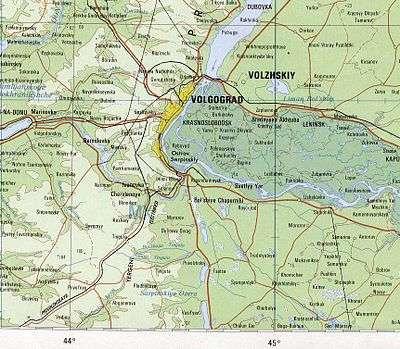

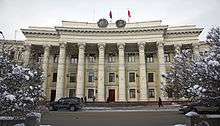
On 10 November 1961, Nikita Khrushchev's administration changed the name of the city to Volgograd ("Volga City") as part of his programme of de-Stalinization following Stalin's death, as he was trying to reduce the "cult of personality". This action was and remains somewhat controversial, given Stalingrad's importance as a symbol of resistance during the war. During Konstantin Chernenko's brief administration in 1984, proposals were floated to revive its historic name. There remains a strong degree of local support for a reversion but intermittent proposals have yet to be accepted by the Russian government.
On May 21, 2007, the Communist Party obtained an important success in the Volgograd mayoral election. Communist candidate Roman Grebennikov was elected as mayor with 32.47% of the vote. Grebennikov is Russia's youngest mayor of a federal subject administrative center.
In 2010, Russian monarchists and leaders of the Orthodox organizations demanded that the city should return to its original name Tsaritsyn, but the authorities rejected their proposal.
On January 30, 2013, the Volgograd City Council passed a measure to use the title "Hero City Stalingrad" in city statements on nine specific dates annually.[19][20][21] On the following dates the title "Hero City Stalingrad" can officially be used in celebrations:
- February 2 (end of the Battle of Stalingrad),
- February 23 (Defender of the Fatherland Day),
- May 9 (Victory Day),
- June 22 (start of Operation Barbarossa),
- August 23 (start of the Battle of Stalingrad),
- September 2 (Victory over Japan Day),
- November 19 (start of Operation Uranus),
- December 9 (Day of the Fatherland's Heroes)[19]
In addition, 50,000 people signed a petition to Vladimir Putin, asking that the city's name be permanently changed to Stalingrad.[20] President Putin has replied that such a move should be preceded by a local referendum and that the Russian authorities will look into how to bring about such a referendum.[22]
Terrorist attacks
On August 24, 2004, the Volga-AviaExpress Flight 1353,[23] a Tupolev Tu-134 aircraft flying from Moscow to Volgograd, exploded in mid-air and crashed as a result of suicide terrorist attack. 34 passengers and 9 crew members were on board the aircraft, all of whom died in the crash. A Siberia Airlines flight bound for Sochi that day was also bombed, killing all 46 who were on board.
At approximately 2:00 p.m. on Monday 21 October 2013 Russian intelligence officers reported a bomb carried by a female suicide bomber exploded on a passenger bus carrying 40 people while stopped at the Lesobaza bus stop.[24] Irina Gogolyeva, a spokesperson from the Russian Emergency Situations Ministry, reported that at least five people died in the blast and seventeen others were injured.[25] On October 22, 2013, Vladimir Markin from Russia's investigative Committee reported that the suicide bomber had been identified as 30-year-old Naida Asiyalova of Dagestan.[26]
On December 29, 2013, a suicide bomb attack occurred at the Volgograd railway station, killing at least seventeen people. It is not clear how many bombers were involved or who they were.[27] The following day a suicide bombing on a trolleybus killed at least fifteen people.[28]
Politics
In 2011, the City Duma canceled direct election of the mayor and confirmed the position of City Manager. This was short-lived, as in March 2012, Volgograd residents voted for relevant amendments to the city charter to reinstate the direct mayoral elections.[29]
Administrative and municipal status

Volgograd is the administrative center of Volgograd Oblast.[30] Within the framework of administrative divisions, it is incorporated as the city of oblast significance of Volgograd—an administrative unit with the status equal to that of the districts.[3] As a municipal division, the city of oblast significance of Volgograd is incorporated as Volgograd Urban Okrug.[4]
Economy
Modern Volgograd remains an important industrial city. Industries include shipbuilding, oil refining, steel and aluminum production, manufacture of machinery and vehicles, and chemical production. The large Volgograd Hydroelectric Plant is a short distance to the north of Volgograd.
Transportation
Volgograd is a major railway junction served by the Privolzhskaya Railway. Rail links from the Volgograd railway station include Moscow; Saratov; Astrakhan; the Donbas region of Ukraine; the Caucasus and Siberia. It stands at the east end of the Volga–Don Canal, opened in 1952 to link the two great rivers of Southern Russia. European route E40, the longest European route connecting Calais in France with Ridder in Kazakhstan, passes through Volgograd. The M6 highway between Moscow and the Caspian Sea also passes through the city. The Volgograd Bridge, under construction since 1995, was inaugurated in October 2009.[31] The city river terminal is the center for local passenger shipping along the Volga River.
The Volgograd International Airport provides air links to major Russian cities as well as Antalya, Yerevan and Aktau.
Volgograd's public transport system includes a light rail service known as the Volgograd metrotram. Local public transport is provided by buses, trolleybuses and trams.
The Volga River still is a very important communication channel.
Volgograd hosts one of the few floating churches in the world:[32] the floating church of Saint Vladimir of Volgograd.[33]
 Trolza-5275 low-entry trolleybus
Trolza-5275 low-entry trolleybus
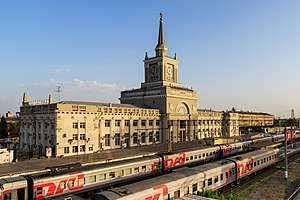

Climate
Under the Köppen climate classification Volgograd has a humid continental climate (Dfa) with a hot summer subtype.
| Climate data for Volgograd | |||||||||||||
|---|---|---|---|---|---|---|---|---|---|---|---|---|---|
| Month | Jan | Feb | Mar | Apr | May | Jun | Jul | Aug | Sep | Oct | Nov | Dec | Year |
| Record high °C (°F) | 12.3 (54.1) |
15.9 (60.6) |
20.5 (68.9) |
29.2 (84.6) |
37.2 (99) |
40.1 (104.2) |
40.9 (105.6) |
42.7 (108.9) |
37.8 (100) |
31.0 (87.8) |
18.5 (65.3) |
12.3 (54.1) |
42.7 (108.9) |
| Average high °C (°F) | −3.5 (25.7) |
−3.3 (26.1) |
3.3 (37.9) |
14.5 (58.1) |
21.4 (70.5) |
26.6 (79.9) |
29.3 (84.7) |
28.1 (82.6) |
21.3 (70.3) |
12.7 (54.9) |
3.4 (38.1) |
−2.0 (28.4) |
12.7 (54.9) |
| Daily mean °C (°F) | −6.3 (20.7) |
−6.6 (20.1) |
−0.5 (31.1) |
9.2 (48.6) |
15.9 (60.6) |
21.0 (69.8) |
23.7 (74.7) |
22.3 (72.1) |
15.6 (60.1) |
8.1 (46.6) |
0.3 (32.5) |
−4.7 (23.5) |
8.2 (46.8) |
| Average low °C (°F) | −9.2 (15.4) |
−9.9 (14.2) |
−4.0 (24.8) |
4.1 (39.4) |
10.1 (50.2) |
15.1 (59.2) |
17.5 (63.5) |
16.2 (61.2) |
10.3 (50.5) |
3.9 (39) |
−2.5 (27.5) |
−7.6 (18.3) |
3.7 (38.7) |
| Record low °C (°F) | −33.0 (−27.4) |
−32.5 (−26.5) |
−25.8 (−14.4) |
−12.8 (9) |
−1.1 (30) |
1.1 (34) |
7.2 (45) |
4.5 (40.1) |
−1.5 (29.3) |
−12.2 (10) |
−25.8 (−14.4) |
−27.8 (−18) |
−33.0 (−27.4) |
| Average precipitation mm (inches) | 38 (1.5) |
30 (1.18) |
28 (1.1) |
28 (1.1) |
39 (1.54) |
41 (1.61) |
35 (1.38) |
30 (1.18) |
29 (1.14) |
29 (1.14) |
34 (1.34) |
45 (1.77) |
406 (15.98) |
| Average rainy days | 9 | 7 | 8 | 12 | 12 | 12 | 11 | 8 | 10 | 11 | 12 | 11 | 123 |
| Average snowy days | 20 | 18 | 11 | 2 | 0.03 | 0 | 0 | 0 | 0.1 | 1 | 9 | 18 | 79 |
| Average relative humidity (%) | 88 | 86 | 81 | 64 | 57 | 56 | 53 | 51 | 61 | 73 | 86 | 89 | 70 |
| Mean monthly sunshine hours | 66.1 | 96.9 | 138.4 | 204.2 | 290.8 | 308.4 | 329.3 | 300.2 | 228.9 | 155.8 | 63.6 | 42.5 | 2,225.1 |
| Source #1: Pogoda.ru.net[34] | |||||||||||||
| Source #2: Weatherbase (sun only)[35] | |||||||||||||
Culture and recreation
.jpg)

A memorial complex commemorating the battle of Stalingrad, dominated by an immense allegorical sculpture The Motherland Calls, was erected on the Mamayev Kurgan, the hill that saw some of the most intense fighting during the battle. At 85 metres it is almost twice the height of the Statue of Liberty in New York.
The Panorama Museum sited on the Volga contains artifacts from World War II. These include a panoramic painting of the battlefield from the location of the monument on Mamayev Kurgan. A rifle of the famous sniper Vasily Zaytsev is also on display.
The Musical Instrument Museum is a branch of the Volgograd regional Museum of local lore.
Education
Higher education facilities include:
- Volgograd State University
- Volgograd State Technical University (former Volgograd Polytechnical University)[36]
- Volgograd State Agriculture University
- Volgograd State Medical University[37]
- Volgograd State University of Architecture and Civil Engineering
- Volgograd Academy of Industry
- Volgograd Academy of Business Administration[38]
- Volgograd State Pedagogical University
Sports
.jpg)
| Club | Sport | Founded | Current League | League Tier | Stadium |
|---|---|---|---|---|---|
| Rotor Volgograd | Football | 1929 | Russian Professional Football League | 3rd | Central Stadium |
| Olimpia Volgograd | Football | 1989 | Volgograd Oblast Football Championship | 5th | Olimpia Stadium |
| Kaustik Volgograd | Handball | 1929 | Handball Super League | 1st | Dynamo Sports Complex |
| Dynamo Volgograd | Handball | 1929 | Women's Handball Super League | 1st | Dynamo Sports Complex |
| Krasny Oktyabr Volgograd | Basketball | 2012 | VTB United League | 2nd | Trade Unions Sports Palace |
| Spartak Volgograd | Water Polo | 1994 | Russian Water Polo Championship | 1st | CVVS |
Volgograd was a host city to 4 matches of the FIFA World Cup in 2018. A new modern stadium, Volgograd Arena, was built for this occasion on the bank of the Volga River to serve as the venue. The stadium has a seating capacity for 45,000 people, including a press box, a VIP box and seats for people with limited mobility.
Notable people
- Vasily Zaytsev, Soviet sniper and a Hero of the Soviet Union
- Kurt Adler, conductor
- Nikolay Davydenko, tennis player
- Sasha Filippov, spy
- Oleg Grebnev, handball player
- Yekaterina Grigoryeva, sprinter
- Larisa Ilchenko, long distance swimmer
- Yelena Isinbayeva, pole vaulter
- Lev Ivanov, association football manager
- Yuriy Kalitvintsev, association football manager
- Elem Klimov, film director
- Alexey Kravtsov, jurist
- Vladimir Kryuchkov, statesman
- Tatyana Lebedeva, jumper
- Maxim Marinin, figure skater
- Maksim Opalev, sprint canoeist
- Aleksandra Pakhmutova, composer
- Denis Pankratov, Olympic swimmer
- Evgeni Plushenko, Olympic figure skater
- Yevgeny Sadovyi, Olympic swimmer
- Natalia Shipilova, handball player
- Yelena Slesarenko, high jumper
- Yuliya Sotnikova, 400m athlete
- Igor Vasilev, handball player
- Oleg Veretennikov, association football player
- Leonid Slutsky, football coach
International relations
Volgograd is twinned with:[39][40]
- Several communities in France and Italy have streets or avenues named after Stalingrad, hence Place de Stalingrad in Paris and the eponymous Paris Métro station of Stalingrad.
References
Notes
- 1 2 3 Charter of Volgograd, Preamble
- ↑ Official website of Volgograd. Конкурс на создание гимна Волгограда будет проведен повторно (in Russian)
- 1 2 3 4 5 Law #139-OD
- 1 2 3 Law #1031-OD
- 1 2 Charter of Volgograd, Article 22
- 1 2 Russian Federal State Statistics Service (2011). "Всероссийская перепись населения 2010 года. Том 1" [2010 All-Russian Population Census, vol. 1]. Всероссийская перепись населения 2010 года (2010 All-Russia Population Census) (in Russian). Federal State Statistics Service. Retrieved June 29, 2012.
- ↑ Russian Federal State Statistics Service (May 21, 2004). "Численность населения России, субъектов Российской Федерации в составе федеральных округов, районов, городских поселений, сельских населённых пунктов – районных центров и сельских населённых пунктов с населением 3 тысячи и более человек" [Population of Russia, Its Federal Districts, Federal Subjects, Districts, Urban Localities, Rural Localities—Administrative Centers, and Rural Localities with Population of Over 3,000] (XLS). Всероссийская перепись населения 2002 года [All-Russia Population Census of 2002] (in Russian). Retrieved August 9, 2014.
- ↑ Правительство Российской Федерации. Федеральный закон №107-ФЗ от 3 июня 2011 г. «Об исчислении времени», в ред. Федерального закона №271-ФЗ от 03 июля 2016 г. «О внесении изменений в Федеральный закон "Об исчислении времени"». Вступил в силу по истечении шестидесяти дней после дня официального опубликования (6 августа 2011 г.). Опубликован: "Российская газета", №120, 6 июня 2011 г. (Government of the Russian Federation. Federal Law #107-FZ of June 31, 2011 On Calculating Time, as amended by the Federal Law #271-FZ of July 03, 2016 On Amending Federal Law "On Calculating Time". Effective as of after sixty days following the day of the official publication.).
- 1 2 3 4 Энциклопедия Города России. Moscow: Большая Российская Энциклопедия. 2003. pp. 81–83. ISBN 5-7107-7399-9.
- ↑ Почта России. Информационно-вычислительный центр ОАСУ РПО. (Russian Post). Поиск объектов почтовой связи (Postal Objects Search) (in Russian)
- ↑ В Волгограде строится самый длинный мост Европы. geo.1september.ru (in Russian). 2009. Retrieved January 4, 2012.
- ↑ Russian Federal State Statistics Service (May 21, 2004). "Численность населения России, субъектов Российской Федерации в составе федеральных округов, районов, городских поселений, сельских населённых пунктов – районных центров и сельских населённых пунктов с населением 3 тысячи и более человек" [Population of Russia, Its Federal Districts, Federal Subjects, Districts, Urban Localities, Rural Localities—Administrative Centers, and Rural Localities with Population of Over 3,000] (XLS). Всероссийская перепись населения 2002 года [All-Russia Population Census of 2002] (in Russian). Retrieved August 9, 2014.
- ↑ Demoscope Weekly (1989). "Всесоюзная перепись населения 1989 г. Численность наличного населения союзных и автономных республик, автономных областей и округов, краёв, областей, районов, городских поселений и сёл-райцентров" [All Union Population Census of 1989: Present Population of Union and Autonomous Republics, Autonomous Oblasts and Okrugs, Krais, Oblasts, Districts, Urban Settlements, and Villages Serving as District Administrative Centers]. Всесоюзная перепись населения 1989 года [All-Union Population Census of 1989] (in Russian). Институт демографии Национального исследовательского университета: Высшая школа экономики [Institute of Demography at the National Research University: Higher School of Economics]. Retrieved August 9, 2014.
- ↑ Lutz-Auras, Ludmilla (2012). "Auf Stalin, Sieg Und Vaterland!": Politisierung Der Kollektiven Erinnerung an Den Zweiten Weltkrieg in Russland (in German). Springer-Verlag. p. 189. ISBN 978-3658008215.
- ↑ Mccauley, Martin (2013). Stalin and Stalinism (3 ed.). Routledge. ISBN 978-1317863687.
10 April 1925: Tsaritsyn is renamed Stalingrad.
- ↑ Breweres Dictionary of 20th Century Phrase and Fable
- ↑ Grant, R. G. (2005). Battle: A Visual Journey Through 5,000 Years of Combat. Dorling Kindersley. ISBN 0-7566-1360-4.
- ↑ Wagner, Margaret; et al. (2007). The Library of Congress World War II Companion. Simon & Schuster. ISBN 0-7432-5219-5.
- 1 2 Decision #72/2149
- 1 2 "Russia revives Stalingrad city name". The Daily Telegraph. 2013-01-31. Retrieved 2013-02-07.
- ↑ "Stalingrad name to be revived for anniversaries". BBC News Online. 2013-02-01. Retrieved 2013-02-07.
- ↑ http://en.itar-tass.com/russia/735173
- ↑ Kurz, Robert W.; Charles K. Bartles (2007). "Chechen suicide bombers" (PDF). Journal of Slavic Military Studies. Routledge. 20: 529–547. doi:10.1080/13518040701703070. Retrieved 30 August 2012.
- ↑ Arkady Irshenko (October 21, 2013). "5 killed in Russia bus explosion; suicide bombing suspected". Cable News Network (CNN). Retrieved 2013-10-21.
- ↑ "Blast kills bus passengers in Russia". Al Jazeera America. October 21, 2013. Retrieved 2013-10-21.
- ↑ "6 dead as female suicide attacker explodes bomb on Russian bus". Fox News Network. October 21, 2013. Retrieved 2013-10-21.
- ↑ "Suicide bombing kills at least 17 in Russia's Volgograd". RT. December 30, 2013. Retrieved December 29, 2013.
- ↑ "Volgograd suicide bombing kills at least 14 (photos, graphic video)". RT. December 30, 2013. Retrieved December 30, 2013.
- ↑ "Волгоград сдался выборам". www.gazeta.ru. 2012.
- ↑ Europa Publications (26 February 2004). "Southern Federal Okrug". The Territories of the Russian Federation 2004. Taylor & Francis Group. p. 174. Retrieved 4 March 2017.
The Oblast's administrative centre is at Volgograd.
- ↑ Иванов открыл в Волгограде самый большой мост в Европе (in Russian). Vesti. Retrieved 2011-02-09.
- ↑ SELF-PROPELLED FLOATING CHURCH LAUNCHED IN VOLGOGRAD
- ↑ Unique Floating Church
- ↑ "Pogoda.ru.net" (in Russian). Retrieved July 7, 2016.
- ↑ "Weatherbase: Historical Weather for Volgograd, Russia". Weatherbase. Retrieved November 17, 2012.
- ↑ "Volgograd State Technical University - Main page". Vstu.ru. August 21, 2011. Archived from the original on September 3, 2011. Retrieved September 15, 2011.
- ↑ Россия. "Волгоградский государственный медицинский университет (ВолгГМУ)". Volgmed.ru. Retrieved 2011-09-15.
- ↑ "Internet Archive Wayback Machine". Web.archive.org. 2007-06-27. Archived from the original on June 27, 2007. Retrieved 2011-09-15.
- ↑ "Friendly relationship at Official website of Volgograd". Archived from the original on December 3, 2009. Retrieved June 13, 2011.
- ↑ "VISIT VOLGOGRAD - RUSSIA - WELCOME TO THE CITY - THE HERO VOLGOGRAD!". www.visitvolgograd.info. Retrieved 2010-01-05.
- ↑ Griffin, Mary (2011-08-02). "Coventry's twin towns". Coventry Telegraph. Retrieved 2013-08-06.
- ↑ "Coventry - Twin towns and cities". Coventry City Council. Archived from the original on 2013-04-12. Retrieved 2013-08-06.
- ↑ Pessotto, Lorenzo. "International Affairs - Twinnings and Agreements". International Affairs Service in cooperation with Servizio Telematico Pubblico. City of Torino. Archived from the original on June 18, 2013. Retrieved 2013-08-06.
- ↑ "広島市の姉妹・友好都市". City.hiroshima.jp. Archived from the original on June 7, 2009. Retrieved July 17, 2009.
- ↑ "Sister Cities International (SCI)". Sister-cities.org. Archived from the original on June 13, 2015. Retrieved April 21, 2013.
- ↑ "Yerevan - Partner Cities". Yerevan Municipality Official Website. City of Yerevan. Retrieved 2016-07-02.
- ↑ "МЕЖДУНАРОДНО СЪТРУДНИЧЕСТВО НА ОБЩИНА РУСЕ - Побратимени градове". Община Русе [Municipality Ruse] (in Bulgarian). Archived from the original on August 5, 2013. Retrieved August 12, 2013.
- ↑ Executive power of Baku city
- ↑ Iran’s Ardabil, Russia’s Volgograd to be sisters, retrieved 24 May 2015
Sources
- Волгоградский городской Совет народных депутатов. Постановление №20/362 от 29 июня 2005 г. «Устав города-героя Волгограда», в ред. Решения №32/1000 от 15 июля 2015 г. «О внесении изменений и дополнений в Устав города-героя Волгограда». Вступил в силу 10 марта 2006 г. (за исключением отдельных положений). Опубликован: "Волгоградская газета", №7, 9 марта 2006 г. (Volgograd City Council of People's Deputies. Resolution #20/362 of June 29, 2005 Charter of the Hero City of Volgograd, as amended by the Decision #32/1000 of July 15, 2015 On Amending and Supplementing the Charter of the Hero City of Volgograd. Effective as of March 10, 2006 (with the exception of certain clauses).).
- Волгоградская областная Дума. Закон №139-ОД от 7 октября 1997 г. «Об административно-территориальном устройстве Волгоградской области», в ред. Закона №107-ОД от 10 июля 2015 г. «О внесении изменений в отдельные законодательные акты Волгоградской области в связи с приведением их в соответствие с Уставом Волгоградской области». Вступил в силу со дня официального опубликования. Опубликован: "Волгоградская правда", №207, 1 ноября 1997 г. (Volgograd Oblast Duma. Law #139-OD of October 7, 1997 On the Administrative-Territorial Structure of Volgograd Oblast, as amended by the Law #107-OD of July 10, 2015 On Amending Various Legislative Acts of Volgograd Oblast to Ensure Compliance with the Charter of Volgograd Oblast. Effective as of the day of the official publication.).
- Волгоградская областная Дума. Закон №1031-ОД от 21 марта 2005 г. «О наделении города-героя Волгограда статусом городского округа и установлении его границ», в ред. Закона №2013-ОД от 22 марта 2010 г «О внесении изменений в Закон Волгоградской области от 21 марта 2005 г. №1031-ОД "О наделении города-героя Волгограда статусом городского округа и установлении его границ"». Вступил в силу со дня официального опубликования (22 марта 2005 г.). Опубликован: "Волгоградская правда", №49, 22 марта 2005 г. (Volgograd Oblast Duma. Law #1031-OD of March 21, 2005 On Granting Urban Okrug Status to the Hero City of Volgograd and on Establishing Its Borders, as amended by the Law #2013-OD of March 22, 2010 On Amending the Law of Volgograd Oblast #1031-OD of March 21, 2005 "On Granting Urban Okrug Status to the Hero City of Volgograd and on Establishing Its Borders". Effective as of the day of the official publication (March 22, 2005).).
- Волгоградская городская Дума. Решение №72/2149 от 30 января 2013 г. «Об использовании наименования "город-герой Сталинград"», в ред. Решения №9/200 от 23 декабря 2013 г. «О внесении изменений в пункт 1 Порядка использования наименования "город-герой Сталинград", определённого Решением Волгоградской городской Думы от 30.01.2013 №72/2149 "Об использовании наименования "город-герой Сталинград"». Вступил в силу со дня принятия. Опубликован: "Городские вести. Царицын - Сталинград - Волгоград", #10, 2 февраля 2013 г. (Volgograd City Duma. Decision #72/2149 of January 30, 2013 On Using the Name of the "Hero City Stalingrad", as amended by the Decision #9/200 of December 23, 2013 On Amending Item 1 of the Procedures for Usage of the Name "Hero City Stalingrad", Adopted by the January 30, 2013 Decision #72/2149 of Volgograd City Duma "On Using the Name of the "Hero City Stalingrad". Effective as of the day of adoption.).
Bibliography
- See also: Bibliography of the history of Volgograd
External links


- Official website of Volgograd
- (in Russian) Official website of Volgograd
- (in Russian) Unofficial website of Volgograd
- Volgograd tourist information
- Sights of Volgograd
- (in German) Stalingrad - Bilder einer erbitterten Schlacht
- Volgograd State University
